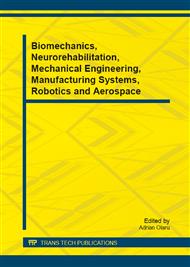p.289
p.297
p.303
p.310
p.316
p.323
p.330
p.334
p.340
Finite Element Modeling of Composites System in Aerospace Application
Abstract:
The characteristics of composite materials are of high importance to engineering applications; therefore the increasing use as a substitute for conventional materials, especially in the field of aircraft and space industries. It is a known fact that researchers use finite element programs for the design and analysis of composite structures, use of symmetrical conditions especially in complicated structures, in the modeling and analysis phase of the design, to reduce processing time, memory size required, and simplifying complicated calculations, as well as considering the response of composite structures to different loading conditions to be identical to that of metallic structures. Finite element methods are a popular method used to analyze composite laminate structures. The design of laminated composite structures includes phases that do not exist in the design of traditional metallic structures, for instance, the choice of possible material combinations is huge and the mechanical properties of a composite structure, which are anisotropic by nature, are created in the design phase with the choice of the appropriate fiber orientations and stacking sequence. The use of finite element programs (conventional analysis usually applied in the case of orthotropic materials) to analysis composite structures especially those manufactured using angle ply laminate techniques or a combination of cross and angle ply techniques, as well considering the loading response of the composite structure to be identical to that of structures made of traditional materials, has made the use of, and the results obtained by using such analysis techniques and conditions questionable. Hence, the main objective of this paper is to highlight and present the results obtained when analyzing and modeling symmetrical conditions as applied to commercial materials and that applied to composite laminates. A comparison case study is carried out using cross-ply and angle-ply laminates which concluded that, if the composition of laminate structure is pure cross-ply, the FEA is well suited for predicting the mechanical response of composite structure using principle of symmetry condition. On the other hand that is not the case for angle-ply or mixed-ply laminate structure.
Info:
Periodical:
Pages:
316-322
Citation:
Online since:
December 2012
Authors:
Keywords:
Price:
Сopyright:
© 2013 Trans Tech Publications Ltd. All Rights Reserved
Share:
Citation:


